
The War Shipping Administration (WSA) was a World War II emergency war agency of the US government, tasked to purchase and operate the civilian shipping tonnage the United States needed for fighting the war. Both shipbuilding under the Maritime Commission and ship allocation under the WSA to Army, Navy or civilian needs were closely coordinated though Vice Admiral Emory S. Land who continued as head of the Maritime Commission while also heading the WSA.

Fort Mason, in San Francisco, California originated as a coastal defense site during the American Civil War. The nucleus of the property was owned by John C. Frémont and disputes over compensation by the United States continued into 1968. In 1882 the defenses were named for Richard Barnes Mason, a military governor before statehood. Fort Mason became the headquarters for an Army command that included California and the Hawaiian Islands from 1904 to 1907. In 1912 the Army began building a port facility with piers and warehouses to be a home base for ships of the Army Transport Service serving Alaska, Hawaii, the Philippines and other Pacific Army posts and focus of Army supply for the Pacific.

The San Francisco Port of Embarkation (SFPOE) was a United States Army command responsible for movement of supplies and troops to and from the Pacific during World War II with extensive facilities in the San Francisco area. SFPOE was established 6 May 1932 and disestablished 1 October 1955. It was originally composed of the long term Pacific terminal at Fort Mason that had been the home port and terminal for the Pacific Army Transport Service ships. That facility was far too limited to serve the requirements of a full port of embarkation. In 1940 the port began expansion to include Army owned and leased facilities throughout the San Francisco Bay area and for a time sub ports at Seattle and Los Angeles. Those eventually became separate commands as the Seattle Port of Embarkation and Los Angeles Port of Embarkation.
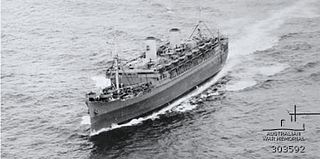
SS Mariposa was a luxury ocean liner launched in 1931, one of four ships in the Matson Lines "White Fleet", which included SS Monterey, SS Malolo, and SS Lurline. She was later renamed SS Homeric.

The New York Port of Embarkation (NYPOE) was a United States Army command responsible for the movement of troops and supplies from the United States to overseas commands. The command had facilities in New York and New Jersey, roughly covering the extent of today's Port of New York and New Jersey, as well as ports in other cities as sub-ports under its direct command. During World War I, when it was originally known as the Hoboken Port of Embarkation with headquarters in seized Hamburg America Line facilities in Hoboken, New Jersey, the Quartermaster Corps had responsibility. The sub-ports were at Boston, Baltimore, Philadelphia and the Canadian ports of Halifax, Montreal and St. Johns. The World War I port of embarkation was disestablished, seized and requisitioned facilities returned or sold and operations consolidated at the new army terminal in Brooklyn. Between the wars reduced operations continued the core concepts of a port of embarkation and as the home port of Atlantic army ships. With war in Europe the army revived the formal New York Port of Embarkation command with the New York port, the only Atlantic port of embarkation, taking a lead in developing concepts for operations.

Combat loading is a special type of unit loading of ships so that embarked forces will have immediately needed weapons, ammunition and supplies stowed in such a way that unloading of equipment will be concurrent with the force personnel and available for immediate combat during an amphibious landing. It gives primary consideration to the ease and sequence with which troops, equipment, and supplies can be unloaded ready for combat, rather than to the efficient use of cargo space as in convoy loading where forces and equipment would be joined in rear or secure areas. The art and science of combat loading were developed in World War II, and contributed greatly to the success of Allied amphibious campaigns. While combat loading usually took place in forward bases, the Western Task Force for the landings in North Africa was combat loaded at the Army's Hampton Roads Port of Embarkation which was called on again for the Sicily force.

The Army Service Forces was one of the three autonomous components of the United States Army during World War II, the others being the Army Air Forces and Army Ground Forces, created on 9 March 1942. By dividing the Army into three large commands, the Chief of Staff, General George C. Marshall, drastically reduced the number of officers and agencies reporting directly to him. The Army Service Forces brought together elements of five different components of the Army: elements of the War Department General Staff (WDGS), especially its G-4 division ; the Office of the Under Secretary of War; the eight administrative bureaus; the nine corps areas, which became service commands; and the six supply arms and services, which became known as the technical services. The Army Service Forces was initially known as the United States Army Services of Supply but the name was changed on 12 March 1943, as it was felt that the term "supply" did not accurately describe the broad range of its activities. The Army Service Forces was abolished on 11 June 1946 and most of its functions were taken over by the War Department General Staff.

SS Munargo was a commercial cargo and passenger ship built for the Munson Steamship Line by New York Shipbuilding Corp., Camden, New Jersey launched 17 September 1921. Munargo operated for the line in the New York-Bahamas-Cuba-Miami service passenger cargo trade. In June 1930 the United States and Mexican soccer teams took passage aboard Munargo from New York to Uruguay for the 1930 FIFA World Cup. The ship was acquired by the War Shipping Administration and immediately purchased by the War Department for service as a troop carrier during World War II. Shortly after acquisition the War Department transferred the ship to the U.S. Navy which commissioned the ship USS Munargo (AP-20). She operated in the Atlantic Ocean for the Navy until returned to the War Department in 1943 for conversion into the Hospital ship USAHS Thistle.
Camp Patrick Henry is a decommissioned United States Army base which was located in Warwick County, Virginia. After World War II, the site was redeveloped as a commercial airport, and became part of City of Newport News in 1958 when the former City of Warwick and Newport News were politically consolidated as a single independent city. The airport is known in modern times as Newport News/Williamsburg International Airport.

The United States Army Transport Service (ATS) was established as a sea-going transport service that was independent of the Navy Department. ATS operated army transport ships for both troop transport and cargo service between United States ports and overseas posts. This service is often confused with the Army Transportation Service, created in France in 1917 to manage American Expeditionary Forces transport. ATS was a branch of the Quartermaster Corps responsible for land and water transport, becoming a separate United States Army Transportation Corps on July 31, 1942.
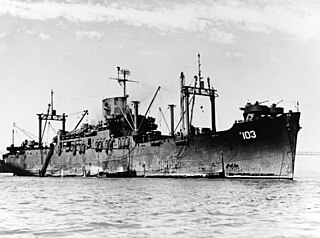
USS President Polk (AP-103) was a President Jackson-class attack transport in the service of the United States Navy during World War II.
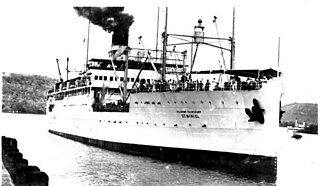
St. Mihiel was a troopship built for the United States Shipping Board by the American International Shipbuilding Corporation at Hog Island, Pennsylvania. The ship was operated from 1922 until mid-1940 as USAT St. Mihiel by the Army Transport Service. In July 1941 the ship was transferred to the Navy which commissioned her USS St. Mihiel with the hull number AP-32. In November 1943, she was transferred back to the Army and converted into the hospital ship, USAHS St. Mihiel.
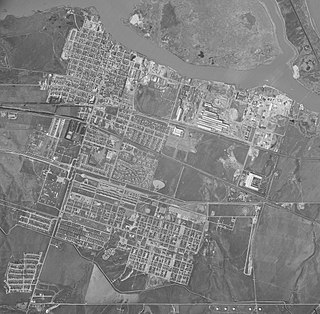
Camp Stoneman was a United States Army facility located in Pittsburg, California. It served as a major troop staging area for and under the command of the San Francisco Port of Embarkation (SFPOE). The camp operated during World War II and the Korean War.
USAT J. W. McAndrew was a Type C3-P&C troop ship for the United States Army during World War II.

USAHS Acadia was the first United States Army Hospital Ship in World War II. Built in 1932 by Newport News Shipbuilding as a civilian passenger/cargo ocean liner for the Eastern Steamship Lines, the ship was in US coastal and Caribbean service prior to its acquisition by the US Maritime Administration in 1941.
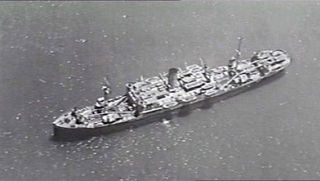
Contessa was a refrigerated cargo and passenger ship of 5,512 GRT built by Barclay, Curle & Co., Glasgow for Vaccaro Brothers & Company launched 18 February 1930. The ship, along with sister ship Cefalu, served ports in the United States, Cuba, and Central America specifically La Ceiba, Honduras which is still a port for the fruit trade. The ship became part of the Standard Fruit Company, a company established by Vaccaro Brothers, and operated as a cargo passenger vessel until taken over at New Orleans by the War Shipping Administration (WSA) on 29 May 1942 with Standard Fruit Company remaining as the WSA operating agent. The ship was later bareboat sub chartered to the United States War Department 14 July 1943 and operated in the Army's Southwest Pacific Area local fleet under the local fleet number X-96 from 18 September 1943 into 1945 as a troop ship. The ship was returned to WSA with Standard Fruit again its agent on 28 May 1946 in Brooklyn until returned to the company for commercial operation at New Orleans on 20 August 1947.

Hampton Roads Port of Embarkation was the Army command structure and distributed port infrastructure in the Hampton Roads area of Virginia supporting the movement of personnel and cargo overseas. It had been activated as the Newport News Port of Embarkation in World War I, deactivated, then reactivated on 15 June 1942.

SS Sea Owl was a Type C3-S-A2 ship built during World War II by Ingalls Shipbuilding, Pascagoula, Mississippi. The ship was converted by Ingalls before delivery on 27 June 1944 into a troop transport for operation by the War Shipping Administration. The ship saw service in the European Theater of Operations with a final trip in January 1946 to Japan and return. The ship was released from troop service in February 1946 and placed in the James River Reserve Fleet 12 August 1946.

SS President Taft was launched as one of the "state" ships, Buckeye State, completed by the United States Shipping Board as cargo passenger ships after originally being laid down as troop transports. Buckeye State had been laid down as Bertrice but was converted and renamed before launching. Originally assigned to the Matson Navigation Company as the Shipping Board's agent, the ship was later renamed President Taft and assigned to Pacific Mail Steamship Company for operation. In 1925 the Shipping Board sold the ship to Dollar Steamship Company. President Taft was operated by Dollar and then its successor American President Lines until requisitioned by the War Department on 17 June 1941.

The Charleston Port of Embarkation (CPOE) was a United States Army Port of Embarkation (POE) responsible for the movement of troops and supplies from the United States to overseas commands. The CPOE was established in Charleston to relieve pressure on the New York Port of Embarkation with initial responsibility largely centered on the West Indies and Caribbean. After the United States entered World War II, Charleston became a POE in its own right. Later in the war, more use was be made of the Port, and it was designated as the home port for Army hospital ships serving the European and Mediterranean theaters. In the spring of 1943 the Chief of Transportation began to train personnel for the operation and maintenance of small boats and amphibian trucks there, before they were moved to Camp Gordon Johnston. The CPOE also served as a training place for army beach landings.






















